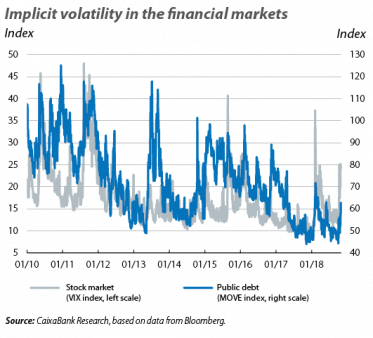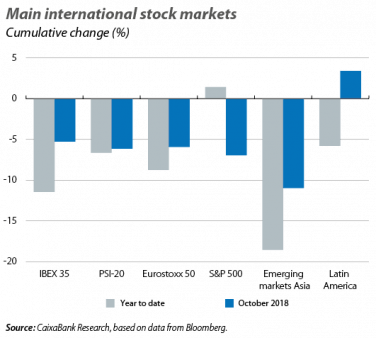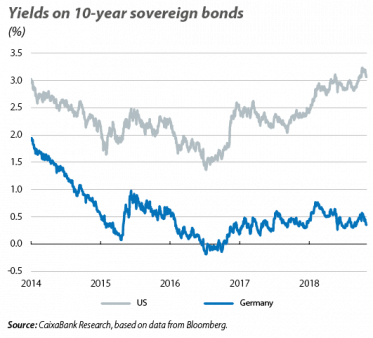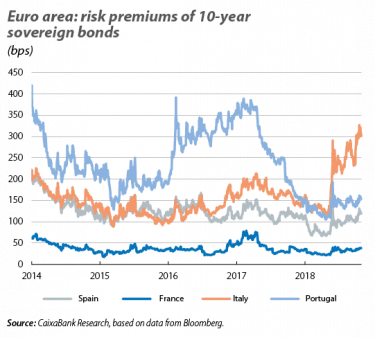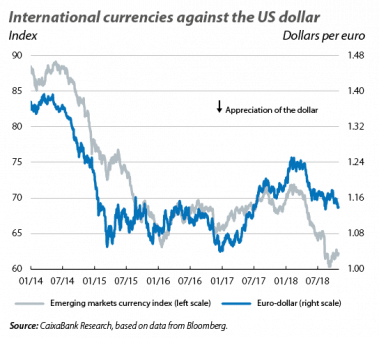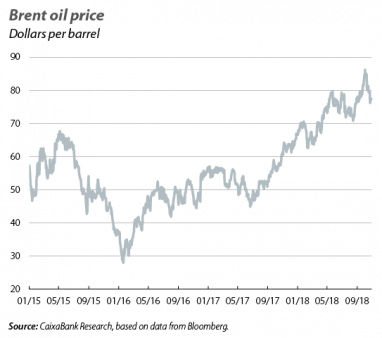Corrections return to the markets
Autumn begins with a new upturn in volatility. After a September with a relatively positive tone, in October financial markets once again suffered an upturn in volatility, with widespread losses across the stock markets of the advanced and emerging economies dominating the economic outlook for the month. Furthermore, in Europe, the situation was accentuated by the new surge in political uncertainty, especially surrounding Italy’s fiscal policy, which caused the risk premiums of the peripheral countries to rise, despite the European Central Bank (ECB) reiterating its commitment to maintaining an accommodative environment over the coming quarters. This upturn in volatility coincides with the warning against complacency recently given by the International Monetary Fund (IMF). Specifically, in its latest report on global financial stability published in October, the IMF recalled that in the accommodative financial environment of recent years, several vulnerabilities (such as the increase in global debt and the high valuations of some assets) have accumulated that could stress the international financial system if faced with a greater-than-expected tightening of monetary conditions.
Stock markets suffer widespread losses. October tempered the constructive tone of September under which the international stock markets had recovered from the instability of the summer. Unlike previous corrections, which had affected emerging and European stock markets the most (while US stock markets continued to hit record highs), in October stock market losses reached the US, generating a sentiment of risk aversion that caused most international stock markets to suffer. In the month as a whole, the US S&P 500 index fell by almost 7%, closely followed by the slightly lower losses of the European stock markets. In the emerging economies, meanwhile, the marked decline of the MSCI index for the bloc as a whole (–8.8%) was the net result of the differing performance between the Asian indices (affected by a cumulative decline of almost 8% in China) and the Latin American indices (with a 10.2% rise in the Brazilian stock market).
The ECB confirms the end of QE. At its October meeting, the ECB kept the parameters of its monetary policy unchanged and reiterated that it expects to continue with the roadmap announced in June. This decision, which was in line with analysts’ and investors’ expectations, was based on a positive view of the macroeconomic scenario (with a balance between a less favourable external environment and the encouraging performance of domestic demand) and on the confidence that inflation will converge towards its target. Thus, net asset purchases are expected to come to an end in December 2018, and there should be no changes to the official interest rates before the closing stages of 2019. In addition, the ECB will continue to purchase assets for a long period of time, keeping the size of its balance sheet constant (by reinvesting the bonds on its balance sheet as they reach maturity).
Uncertainty penalises the euro area periphery. Despite the fact that the ECB’s decisions continue to underpin accommodative monetary conditions, throughout October the risk premiums of the euro area periphery were volatile and showed a tendency to spike. The main factor behind this instability was political uncertainty, especially surrounding fiscal policy in Italy, where the risk premium consolidated its position above 300 bps, briefly surging to levels not seen since 2013. In addition, Moody’s downgraded Italy’s sovereign rating (from Baa2 to Baa3, still investment grade), while S&P also downgraded its outlook (from stable to negative) despite keeping the rating at BBB. In this context, the risk premiums of Spain and Portugal were pushed upwards, albeit more moderately. In fact, Portugal managed to narrow the gap between its risk premium and that of Spain, following Moody’s improvement of its credit rating (from Ba1 to Baa3), giving it an investment grade rating once again. This move by Moody’s followed the decisions taken by Fitch and S&P in recent quarters and, for the first time since the end of 2011, the three big rating agencies have now assigned Portugal an investment grade rating.
The US dollar continues to show strength. The messages of the US Federal Reserve Bank (the Fed) continue to reinforce the strategy of gradual increases to the reference rates. Thus, in October, investors reacted with an increase in US yields which, in the case of the 10-year bond, caused it to temporarily exceed 3.20% (+15 bps compared to the end of September). Nevertheless, this movement was undone as the stock market corrections took hold and investors sought out safe-haven assets, such as US government debt. The conviction in the Fed’s tightening of its monetary policy can also be seen in the FX market. In October, the dollar strengthened against the major advanced economy currencies (the euro and the pound depreciated by slightly more than 2%, while the yen appreciated by slightly more than 0.5%), as well as against the major emerging economy currencies (with the exception of the Brazilian real, which appreciated significantly in response to the electoral victory of the far right-wing candidate, Jair Bolsonaro).
The price of oil moderates. In October, the price of the barrel of Brent oil fell slightly, from 85 dollars at the beginning of the month down to around 75 dollars. In recent months, the reduction of exports from Iran and the cuts in crude oil production in excess of those agreed (among OPEC, Russia and other partners) have pushed oil prices up. In view of these factors, and with the US sanctions against Iran coming into force in November, the upcoming December meeting between OPEC, Russia and other countries included in the agreement will address the possibility of extending the agreement (otherwise, the current agreement will expire at the end of 2018).
